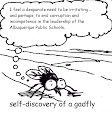Before beginning, I would like to draw a distinction among the students who walked out in protest over the PARCC exam; this post is about students who walked out on principle as opposed to those who simply went along for the hell of it.
Students have Constitutionally protected human rights to protest. They have also, as good citizens, the obligation to follow the rules.
Students who walked out, believe they are being civilly disobedient; a behavior that is often celebrated in cultural heroes.
civil disobedience: refusal to obey laws as a way of forcing the government to do or change somethingThe leadership of the APS consider the students who walked out, to be "breaking the rules" and liable for consequences.
So, civil disobedience or simple disobedience?
The distinction is not without difference.
Those who make peaceful revolution impossibleCivil disobedience is almost never the appropriate first step in forcing change. Students argue this wasn't their first step; that they have made other attempts to force change and, that their efforts were futile.
will make violent revolution inevitable." John F. Kennedy
If the basic purpose of democracy is to allow peaceful revolution; the democracy must respond in good faith to peaceful revolution. If students did in fact make civilly obedient efforts to provoke change, and if those efforts did not result in "the government's" good faith response, then "the government" provoked the disobedience.
The underlying and yet to be examined problem the PARCC protests illustrate is; the lack of control over students in schools.
The number of "out of control*" students is APS is growing; in both absolute and relative terms;
- the absolute number of students who are out of control is increasing and, as "under control" students flee to charter schools,
- the relative proportion of out of control to under control students left in classrooms will increase at a faster rate than their absolute number.
The out of control in students is the result of years and years of the executive and administrative permission of prohibited behavior*;
- Students are told to not do certain things,
- they are promised "consequences" if they do,
- they do those things anyway and
- meaningful consequences are rarely if ever delivered.
Students will become increasingly out of control for as long as the leadership of the APS keeps their heads buried in the sand over student discipline and chronically disruptive students. Asked for a PowerPoint presentation on student discipline in the APS, link, the leadership of the APS is stonewalling; refusing to be candid, forthright and honest with stake and interest holders about their failure to keep students under control at school.
 They are enabled by the Journal
They are enabled by the Journaland its Editor in Chief Kent Walz,
who relentlessly refuse to
investigate and report upon
student discipline in the APS.
photo Mark Bralley

No comments:
Post a Comment